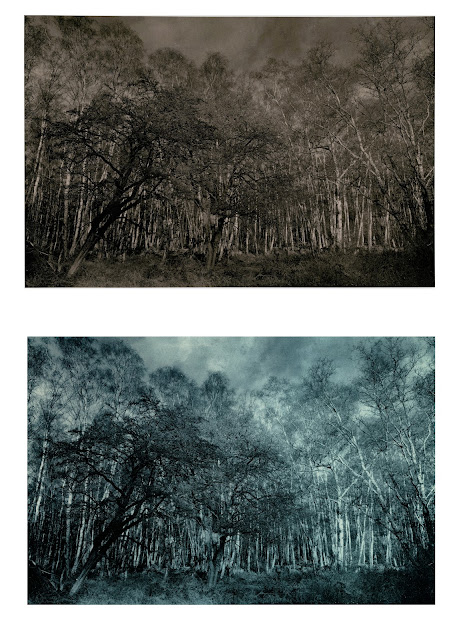Conclave for the Alders: Toning the Lith
I suppose lith and toning for me is as close as one gets to alchemy. Most of the rest of film and paper development is scientific with formulas, processes, and repeatable results. Lith and toning much less so. I also suppose this is the basis of my love hate relationship with them. They hold the promise, often illusive, of a more delicate or powerful image. I have had my share of what I at least think of as success and that tantalizes and draws me back to being the alchemist for a few hours.
This session is no different. Toning on lith is certainly an area I am still finding my balance in. Lith for me has become usefully predictable as I hone my methods, while not completely taming its ability to completely transform an image.
Some of the images I printed in the last of the lith session on the series Conclave for the Alders I set about toning. Today my emphasis was on iron blue toning using the Moersch MT7 kit which I am getting to the end of now. This means I will need to replenish, and I am contemplating the Cobalt kit as it has nicer more muted blue tones or gold toning which gets to blues on lith as well.
All this series I bleached back first in Fish and Chips bleach (1+9) before washing and toning in iron blue toner. The blue toner typically takes less than a minute to achieve the look.
I mix the following
- Part 1 5ml
- Part 2 5ml
- Part 3 10 ml
- Part 4 5 ml
- Water 500ml
I mix a small quantity and use 8x10 trays and there is just enough to do the job at 500ml. The toner does not last, and I prefer to tone the prints before the blue residue forms and starts to stain the paper. This gives me something like 10-20 minutes to work with.
I like to 'over-tone' with the toner knowing I can use a light alkali solution (2ml 10% ammonia per liter of water) to reduce the blue back. Indeed, one nice feature of blue toning is the ability to take the blue away entirely with an alkali solution. In this case, gentle agitation of a minute or so tones down the brightest blues and shifts the color towards blue-gray.
This first image was a lith print that I used only blue toner on. It gives a conventional look, even replacement of the silver across the image with blue tones most notable in the highlights. I present the original and blue toned images here.
 |
| Blue toned comparison |
The bleaching step was helpful in increasing the contrast in the original image. I wish I had a scan to show as I was tempted to fix the image at that point as it took the dense even tone of the image and brought out the highlights well. Still the blue toned version exhibits the improved contrast.
The next image had been selenium toned. Starting life as a lith on Forte Polywarmtone (PWT) I toned it in selenium 1+3 to reduce the green cast and got a warmer color. Since the iron does not affect the selenium the shadow tones remained as they were with highlights getting the blue color as the selenium had not been affected by the iron.
 |
| Selenium-Iron Blue Split Toning Forte PWT |
I am not sure about the color combination of the warm brown and light blue, but the image does show a highly effective split in the toning. It does effectively break out the sky for the blue vs the trees which remain primarily in the selenium warmer tones.
 |
| Selenium-Iron Blue Split Toning Oriental Seagull |
Again, the bleach before toning helped improve contrast and reduce the density. The blue invades the mid-tones. By now the toner has started to accumulate residue and the paper has a faint blue stain.
Finally, a more experimental print. This one I bleached back until the highlight detail was gone and the mid-tones were well bleached as well. I attempted then to restore the highlights with a very dilute Sepia toner and some of the very lightest details did come in warm, but the process stopped. I next moved to redeveloping in the old lith developer from yesterday and let this run at least 10 minutes until the detail returned in the bleached areas. I then applied iron blue toner.
 |
| Iron Blue with Sepia and Lith Redevelopment Oriental Seagull |
Comments